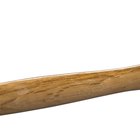
Jeans manufactured by Levi Strauss and Company include light and dark stonewashed denim and rigid selvage. But the best known model, the 501 Original Jeans, require the owner to wash the jeans for a proper fit. Levi jeans entered the market in the 1870s, the brainchild of Levi Strauss and partner Jacob Davis. Proof of the exact date is unknown due to the loss of company records in the San Francisco earthquake and fire of 1906. While the 501 model continues in production, jean collectors look for vintage 501 pairs, identifiable through careful examination of pant details.

Examine the jean fabric. New Levi 501 jeans use heavier denim, while other models, including the 200 series, use thinner denim. Examining the fabric alone does little to date a pair of 501 jeans; however, during times of cotton shortages, including during the 1970s, jeans made from denim used thinner weaves. The denim also thins on well-worn jeans as washing and wearing reduces the thickness.

Look at the back of the jeans. A leather patch sewn near the right-hand side of the waistband dates the pants to before World War II. A painted paper label and a back red tab, rather than stitched label, dates your pants to the World War II era when paint saved valuable thread for the war effort. The heavy-paper label introduced in the late 1950s continues in use today. Pants without back belt loops date your pair to production prior to 1922. A back cinch, metal buckle device used to tighten the waist dates the jeans to pre-1947 production. If your pants have only one rear pocket, your pair dates to manufacture before 1901. Rivets made the Levi jeans a sturdy work clothes option, but in 1966 the rivets disappeared from the back pockets, and a bar tack stitch appeared in place of the round metal studs.

Examine the Levi tab, the red cloth identification tag sewn into the back pocket seam. The tab appeared first in 1936. “LEVI” stitched on both sides of the tab marks pants from the early 1950s. In 1971, a copyright symbol was added to the tab.

Turn the pants inside out and examine the fabric. If your pants feature felled inseams, which are seams without raw edges, date your pants to the 1910s. Pants with metal rivets on the inside but with pockets sewn over the rivets on the exterior, date your jeans to post-1937 production. The presence of a red-colored selvage on the inside of the denim fabric edges dates the pants to the late 1920s.

Check the fly opening. A zippered front closure means your pants date to 1954 or after, although for purists a zippered 501 is a 501Z model.
Related Articles

Levis Jeans Label History

How to Repair a Rivet Type Button on ...

How to Identify Ralph Lauren Labels

How to Identify Vintage Levis

How to Find the Serial Number on an ...

How to Date a Seiko Watch

What Is the Difference Between Levi 505 ...

How to Identify Gruen Watches

How to Remove a Leather Tag From Levi's

What Is the Difference Between Denim & ...

How to Tell How Old Levi's Jackets Are

The History of Denim Jackets

Difference Between Red Tag & Orange Tag ...

How to Tell if a Baseball Jersey is ...

The History of Cargo Pants

How to Spot Fake Ralph Lauren Clothes

How to Tell Fake Coogi Pants From the ...

How to Tell If a Ladies Rolex Is Real

How to Evaluate Invicta Watches

How to Spot Fake NBA Jerseys
References
- Levi's Jeans: Men
- Vintage Levi's Jeans Guide
- "Images of America: Levi Strauss & Co."; Lynn Downey; 2007
Writer Bio
Lee Grayson has worked as a freelance writer since 2000. Her articles have appeared in publications for Oxford and Harvard University presses and research publishers, including Facts On File and ABC-CLIO. Grayson holds certificates from the University of California campuses at Irvine and San Diego.
Photo Credits
Dmitry Kalinovsky/iStock/Getty Images